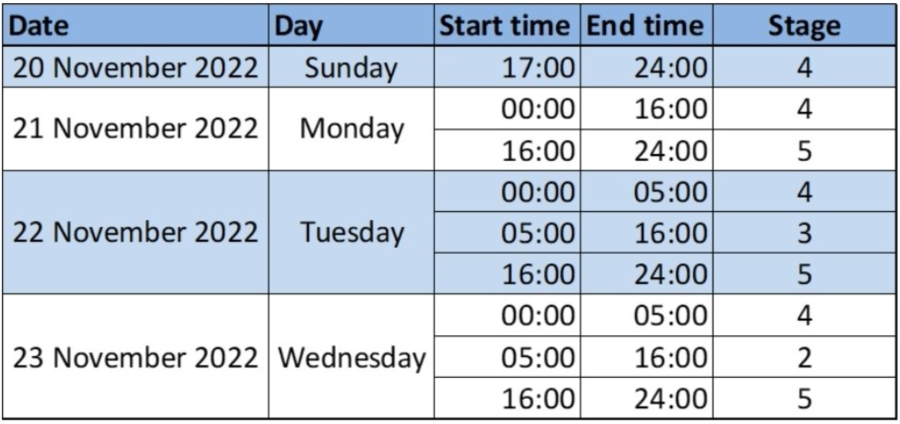- Loadshedding is set to get worse in the coming months as South Africans prepare for the holiday season, according to Eskom.
- Eskom reportedly has run out of diesel to operate its OCTGs, run out of money to buy more diesel and only expects to get more diesel by 1st April 2023.
- As the utility suffers wide-ranging breakdowns amounting to 14 495MW of capacity loss, South Africans will have to face the full brunt of power outages without diesel generation to cushion the blow.
*Update: At 12:30 today, Eskom announced that Stage 5 loadshedding would not be implemented and instead Stage 4 loadshedding will continue until 05:00 on Tuesday.
Thereafter, Stage 2 will take place during the day from 05:00 to 16:00 and Stage 4 in the evenings until 05:00 “until further notice.”
#LoadsheddingUpdate#stage4 loadshedding (instead of Stage 5) will be implemented continuously until 05:00 on Tuesday morning. Thereafter Stage 2 loadshedding will be implemented daily at 05:00 – 16:00. Stage 4 will be implemented daily at 16:00 – 05:00 until further notice.
— Eskom Hld SOC Ltd (@Eskom_SA) November 21, 2022
The original article follows:
The outlook on the loadshedding situation in South Africa has grown dimmer since last week, with Eskom announcing erratic and heightened levels of rotational power cuts for the time being.
#POWERALERT1#Stage4 loadshedding will be implemented at 17:00 this afternoon until 16:00 on Monday. Various stages of loadshedding will be implemented during the week pic.twitter.com/UlfcFPBYlx
— Eskom Hld SOC Ltd (@Eskom_SA) November 20, 2022
On Sunday Eskom suspended loadshedding from 08:00 suddenly, “owing to sufficient recovery in generating capacity and pumped storage dam levels,” the company said.
The utility said loadshedding would then return from 17:00, with Eskom confirming the stages. From no loadshedding, South Africa leapt into Stage 4 power cuts from Sunday evening into Monday morning.
Eskom then published its loadshedding schedule for the first three days of the week, and there are numerous stage changes to be expected:

The highest stage will be Stage 5 which will be implemented on Monday from 16:00 to 24:00 and Tuesday from 16:00 and 24:00. The rest of the week will be at Stage 4 and then on Wednesday during the day from 05:00 to 16:00 Eskom will mercifully go down to Stage 2 only to go back to Stage 5 from as the evening hits.
“Changes in the stages of loadshedding will be more erratic due to the absence of the buffer that is normally provided by the diesel generation capacity between generating unit breakdowns,” the utility says in a statement published to its official Twitter account.
Breakdowns are rife across its fleet of generating units. Three units at Kusile Power Station are offline due to repairs (one of the units had a chimney structure that exploded) and will remain offline “for a few months.”
Unit 1 of the Koeberg Nuclear Power Station is also generating at a lower output over the next three weeks. Sunday saw three generating units taken offline at each the Arnot, Grootvlie and Majuba power stations for repairs.
The national power grid is bereft of 14 495MW of capacity, with a further 5 354MW offline for planned maintenance.
Energy Analyst, Chris Yelland reportedly contacted Eskom on Sunday and received more clarification about the utility’s diesel woes. According to an Eskom spokesperson, “The diesel tanks have physically run out, and the diesel tanks for the Eskom OCGTs (Open Cycle Gas Turbines) are empty.”
I have just contacted the Eskom spokesperson by phone and received the following clear answers in respect of Eskom diesel supplies for the emergency diesel driven open cycle gas turbines at Gourikwa and Ankerlig:
— Chris Yelland (@chrisyelland) November 20, 2022
No diesel to power the turbines means that South Africans will have to face the full brunt of power outages as more generating units are taken offline for repairs. The diesel was used to mitigate some of the capacity loss caused by the downed units.
Apparently, Eskom has run out of funds to buy more diesel, with the spokesperson noting that the utility has already spent 2x the budget for diesel in the current financial year.
The spokesperson confirms that Eskom has so far this year spent R11 billion on diesel just to cushion the blow of loadshedding, and will now be without diesel until 1st April 2023 “unless someone comes up with the money for Eskom” to pay, order and deliver the fuel for its OCGTs.
Eskom was reporting since the last few weeks of October that it was running out of diesel, and even as they were aware that the fuel was steadily depleting they had no recourse or measure in place to amend the issue well into November.
With Eskom’s warning of erratic stage changes expected for the next few months, we advise you to check out the popular loadshedding tracking app EskomSePush for Android and iOS to make sure you aren’t left in the dark. We’ll be using it, that’s for sure.
[Image – David Tomaseti on Unsplash]

